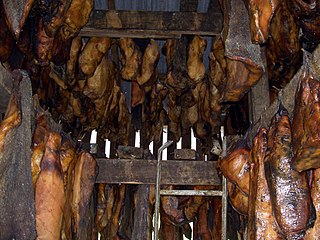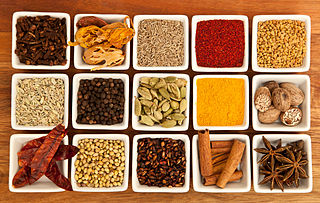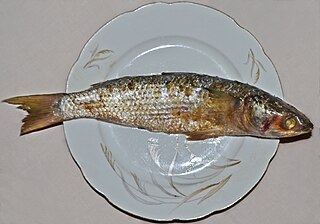Related Research Articles

Roe or hard roe is the fully ripe internal egg masses in the ovaries, or the released external egg masses, of fish and certain marine animals such as shrimp, scallop, sea urchins and squid. As a seafood, roe is used both as a cooked ingredient in many dishes, and as a raw ingredient for delicacies such as caviar.

The ticto barb or twospot barb is a species of subtropical freshwater fish belonging to the family Cyprinidae. It is a native of the upper Mekong, Salwen, Irrawaddy, Meklong and upper Charo Phraya basins in the countries of Nepal, India, Pakistan, Myanmar, Bangladesh, Thailand, and Sri Lanka. It has frequently been confused with the Odessa barb in the aquarium trade, but in that species the male is reddish-orange.

Prahok is a salted and fermented fish paste used in Cambodian cuisine as a seasoning or a condiment. It originated as a way of preserving fish during the months when fresh fish was not available in abundant supply. Because of its saltiness and strong flavor, it was used as an addition to many meals in Cambodian cuisine, such as soups and sauces. A Cambodian saying goes, "No prahok, no salt", referring to a dish that is of poor flavor or bland thus highlighting its essentiality in Cambodian cuisine. Prahok has a strong and distinct smell, earning the nickname "Cambodian cheese". Prahok is usually eaten as a main course with white rice and vegetables such as yardlong beans, cucumbers, winged beans and Thai eggplant.

Assamese cuisine is the cuisine of the Indian state of Assam. It is a style of cooking that is a confluence of cooking habits of the hills that favour fermentation and drying as forms of preservation and those from the plains that provide extremely wide variety of fresh vegetables and greens, and an abundance of fish and meat. Both are centred on the main ingredient — rice. It is a mixture of different indigenous styles with considerable regional variations and some external influences. The traditional way of cooking and the cuisine of Assam is very similar to South-East Asian countries such as Thailand, Burma (Myanmar) and others. The cuisine is characterized by very little use of spices, little cooking over fire, and strong flavours due mainly to the use of endemic exotic fruits and vegetables that are either fresh, dried or fermented. Fish is widely used, and birds like duck, pigeon, squab, etc. are very popular, which are often paired with a main vegetable or ingredient; beef used to be eaten before British colonialism, and some continue to do so. Preparations are rarely elaborate. The practice of bhuna, the gentle frying of spices before the addition of the main ingredients so common in Indian cooking, is absent in the cuisine of Assam. The preferred oil for cooking is the pungent mustard oil.

Hákarl is a national dish of Iceland consisting of a Greenland shark or other sleeper shark that has been cured with a particular fermentation process and hung to dry for four to five months. It has a strong ammonia-rich smell and fishy taste, making hákarl an acquired taste.

Fresh fish rapidly deteriorates unless some way can be found to preserve it. Drying is a method of food preservation that works by removing water from the food, which inhibits the growth of microorganisms. Open air drying using sun and wind has been practiced since ancient times to preserve food. Water is usually removed by evaporation but, in the case of freeze-drying, food is first frozen and then the water is removed by sublimation. Bacteria, yeasts and molds need the water in the food to grow, and drying effectively prevents them from surviving in the food.

Byzantine cuisine was the continuation of local ancient Greek cuisine, ancient Roman cuisine and Mediterranean cuisine. Byzantine trading with foreigners brought in grains, sugar, livestock, fruits, vegetables and spices that would otherwise be limited to specific geographical climates.

Pla ra, similar to padaek in Laos, is a traditional Thai seasoning produced by fermenting fish with rice bran or roasted rice flour and salt fermented in a closed container for at least six months. Fermented fish seasoning are commonly found in Cambodian, Lao, Mon, Thai and Vietnamese cuisine. Pla ra has a very strong smell, which is considered unpleasant by some people. Its flavors are salty and sour, depending on the amount of salt put in and lactic acid resulting from fermentation process.

Naga cuisine is the traditional cuisine of the Naga people of Nagaland, India. It features meats and fish, which are often smoked, dried or fermented.

The cuisine of ancient Egypt covers a span of over three thousand years, but still retained many consistent traits until well into Greco-Roman times. The staples of both poor and wealthy Egyptians were bread and beer, often accompanied by green-shooted onions, other vegetables, and to a lesser extent meat, game and fish.

Fesikh or fseekh is a traditional celebratory ancient Egyptian dish. It is eaten by Egyptians during the Sham el-Nessim festival in Egypt, which is a spring celebration from ancient Egyptian times and is a national festival in Egypt. Fesikh consists of fermented, salted and dried gray mullet of the genus Mugil, a saltwater fish that lives in both the Mediterranean and the Red Seas.

Surströmming is lightly salted fermented Baltic Sea herring traditional to Swedish cuisine since at least the 16th century. Surströmming or fermented herring is distinct from fried or pickled herring.

Anchovies are small, common saltwater forage fish in the family Engraulidae that are used as human food and fish bait. There are 144 species in 17 genera found in the Atlantic, Indian, and Pacific Oceans. Anchovies are usually classified as oily fish. They are small, green fish with blue reflections due to a silver longitudinal stripe that runs from the base of the caudal fin. They range from 2 centimetres (0.79 in) to 40 centimetres (16 in) in adult length, and the body shape is variable, with more slender fish in northern populations.

Kaeng tai pla is a curry of southern Thai cuisine. Its name is derived from tai pla, a salty sauce made from fermented fish entrails, which gives the curry a strong smell and flavor.

Eru is a soup from Cameroon. It is a specialty of the Bayangi people, of the Manyu region in southwestern Cameroon. It is vegetable soup made up of finely shredded leaves of the eru or okok. The eru is stewed with waterleaf or spinach, palm oil, crayfish, and either smoked fish, cow skin (kanda) or beef.

Mizo cuisine is the traditional cuisine of the Mizo people of Mizoram, India. Mizos are traditionally rice eaters.

Balao-balao, also known as burong hipon, is a Filipino condiment of cooked rice and whole raw shrimp fermented with salt and angkak. Once stir-fried, it can be eaten as is with rice or used as a dipping sauce for grilled or fried dishes. Depending on the salt content, it is fermented for several days to weeks. The lactobacilli involved in the fermentation process of the rice produces lactic acid which preserves and softens the shrimp.
Hentak is a thick fermented paste in Manipuri cuisine made with sun-dried fish powder and the petioles of aroid plants. The small Indian flying barb fish are sun dried on bamboo trays and crushed to powder. The aroid petioles are cut into pieces and left in the sun for one day, then in equal parts with the fish powder the mixture is sealed in an earthen pot and fermented for around one week.

Funge or fúngi (Angola) or mfundi is a traditional African swallow made of cassava flour whisked into boiling water. It can also be made with sorghum, maize, or millet. It can be served with textured vegetable, fish, or meat stew, as well as other vegetable, meat, and fish dishes. Funge is a staple food in African cuisine. Some richer and more flavorful versions may be made with stock, like fish stock, instead of water. It is also known as bidia.
Lumlom is a pre-colonial Filipino fermented fish dish originating from the province of Bulacan in the Philippines. It is uniquely prepared by burying the fish in mud for a day or two, allowing it to ferment slightly. After fermentation, it is cleaned and cooked as paksiw sa tuba, with spices, nipa vinegar, and sometimes coconut cream. It is popularly eaten as pulutan.
References
- ↑ Prakash, Jyoti. Himalayan Fermented Foods. CRC Press. p. 149.
- ↑ Bhatt, Pankaj (2020). Recent Advancements in Microbial Diversity. Elsevier. p. 452. ISBN 9780128212660.